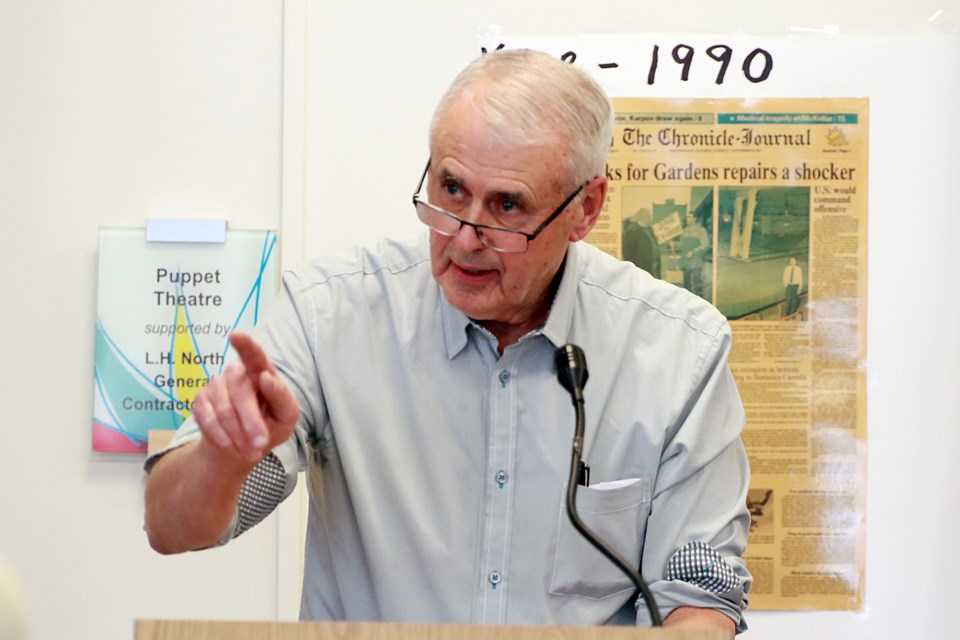THUNDER BAY – It’s not often taxpayer watchdogs and the politicians they’re watching see eye to eye on anything.
In Thunder Bay, there was at least one area that the Concerned Taxpayers of Thunder Bay, a small group of residents unhappy with the prospect of a 6.2 per cent tax-levy increase, before growth, and Mayor Ken Boshcoff agree upon.
Both would like to see the city’s 2,220-strong workforce pared, and both believe it can be done via attrition, combining jobs and eliminating redundancies to create a sleeker municipal machine that helps slash the city’s bottom line.
“You have to find out what may not be useful anymore,” Boshcoff told a crowd of about 15 residents on Saturday at a feedback session put on by the Concerned Taxpayers at the Mary J.L. Black Library.
Ray Smith, the long-time head of the taxpayer group agreed, saying even when you remove the city’s police force from the equation, Thunder Bay is still top heavy.
“Five-hundred-and-forty alone are on the Sunshine List, and that’s only a quarter of the total workforce. It’s not sustainable and some of the people are having a hard time paying taxes. They’re strapped. They only have so much money coming in,” said Smith, who in the past has opposed closing Fort William Gardens and replacing it with a new arena and was against the development of Prince Arthur’s Landing a decade-and-a-half ago.
However, the third-term mayor said it’s not as simple as just cutting jobs. As he’s said multiple times since being elected, the city likely has 20,000 to 25,000 people living here unaccounted for in the census, which Boshcoff said needs to be recognized by Queen’s Park.
“We, as a regional centre, require provincial designation as a regional centre,” Boshcoff said, noting the city could then access funding to help cover the cost of additional service currently being underfunded.
“It’s a door that needs to be knocked open.”
Boshcoff, who was joined by first-time Couns. Greg Johnsen and Kasey Etreni, took questions from the crowd, the debate getting heated at times.
Suggestions included a hybrid fire department, made up largely of volunteer firefighters, and putting to rest, at least for now, major projects like the indoor turf facility, the waterfront art gallery and a planned $11-million revamp of the city’s downtown north core.
Shane Judge, a former journalist, mayoral and at-large candidate, said he’d like to see organizations like Synergy North, Tbaytel and the District Social Services Administration Board combine administrative forces in areas like realty, payroll and human resources to trim the fat.
“We could eliminate a lot of jobs, providing the same services, without firing people because of all the retirements. We could work out a system where we could save money, without laying a lot of people off.”
“But you people have to actually step up. This is going to be the great test for this council. Is somebody going to come forward with an idea for change, or are you going to rubber stamp as administration has refused over the years to change the status quo?”
Etreni asked for patience while the newly elected council, which includes five new faces, works its way through the budget process.
She assured Judge that cost-saving ideas have been discussed, just not publicly yet.
“Right now, I’m trying to gather the information to see if that even makes sense,” Etreni said.
Judge, who thinks the city should dip into reserves to help limit the looming tax increase, said residents must send a signal to politicians and the rest of the community, as activists, about where they believe the city should go.
“We have to start at the top and it starts at city council,” he said.
Boshcoff has said he'd like to limit the tax levy increase to under two per cent, while Smith said he wants no increase at all and agreed with Judge about using reserves to offset the city's planned increased spending. The tax levy is the amount of money the city needs from all taxpayer groups to cover the budget, and does not necessarily reflect the actual tax-rate increase.
